 |
||
|
|||||||
| Beaver Island Places | Excursions | Projects | Artists | History | Home |

After a couple years of mild winters where we wondered if the Island would ever get snow again like when we were kids, or whether the world was just different now due to global warming, this year gave us a little more of a challenge. On St. Patrick’s Day we still had snow banks along Main Street which allowed us to stand above the cars, and the harbor was still well frozen.
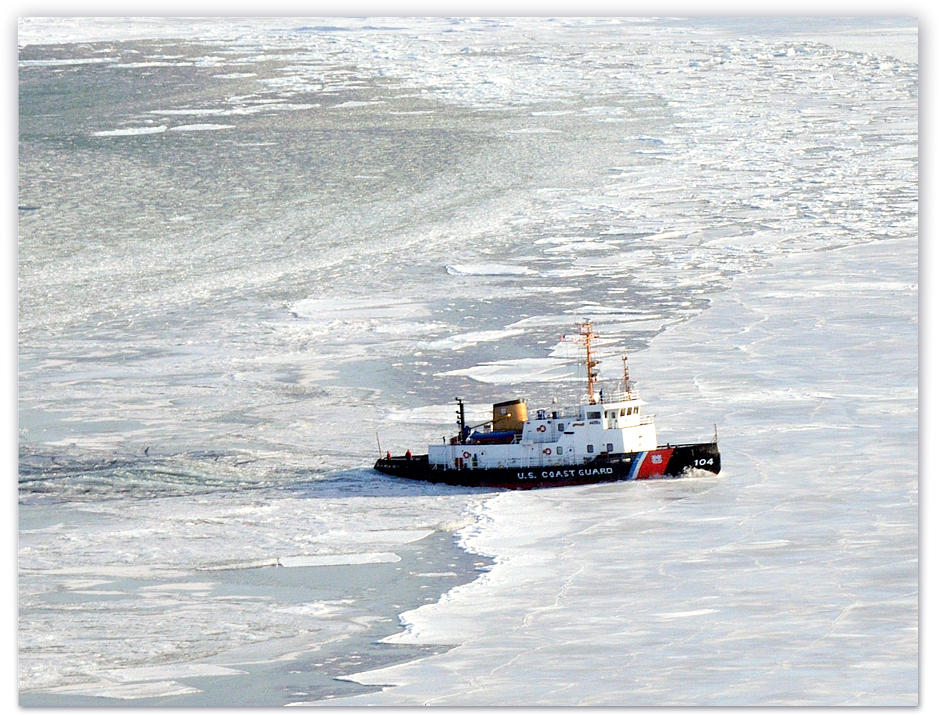
In the third week of March, despite stockpiling as much fuel as last year, the Island was running out. Gas had to be rationed, with a $20 per car per trip limit. For some that was only enough for two trips to town.
The Emerald Isle was chartered for a special run on March 22 to bring a 9,000 gallon tanker truck. The 140' icebreaking tug Biscayne Bay, based in St. Ignace, would make her way to Charlevoix, break its way through ¼ mile of ice that blocked the open channel to Round Lake, escort the Emerald Isle to Beaver Island, break out our harbor (which was still frozen well beyond the entrance), and then escort the ferry back to Charlevoix.
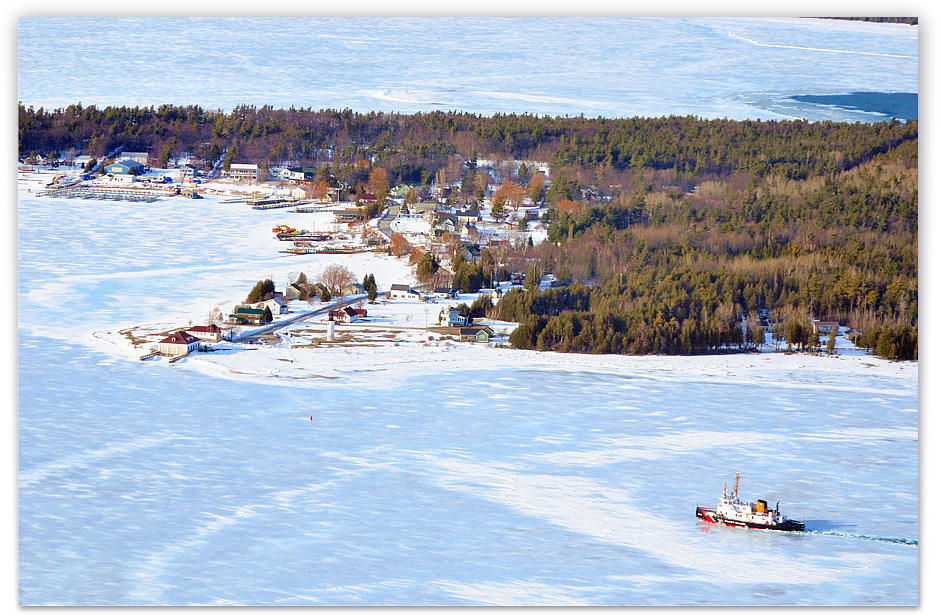
All morning Islanders eagerly awaited the icebreaker and the ferry on the horizon. Frequent calls were made to the airports to inquire if pilots could see the ships. Around noon, when the Emerald Isle had planned to depart Charlevoix, it was learned that the 662-ton Biscayne Bay, capable of breaking ice 20” thick, was mired down in heavy ice near Grays Reef. It was joked that the many snowmobile trips to Mackinaw City must have packed in the frost, causing an unusual thickness to the ice bridge.
With everyone on the Island eagerly peering at the horizon, at 2:00 I got the chance to go up in the air in search of the overdue icebreaker. Flying over the encrusted harbor and the ice shelf to Garden and then past Hog Island was an exciting experience—truly surreal, like watching a slow-motion film about the arctic, yet at the same incredibly fast.
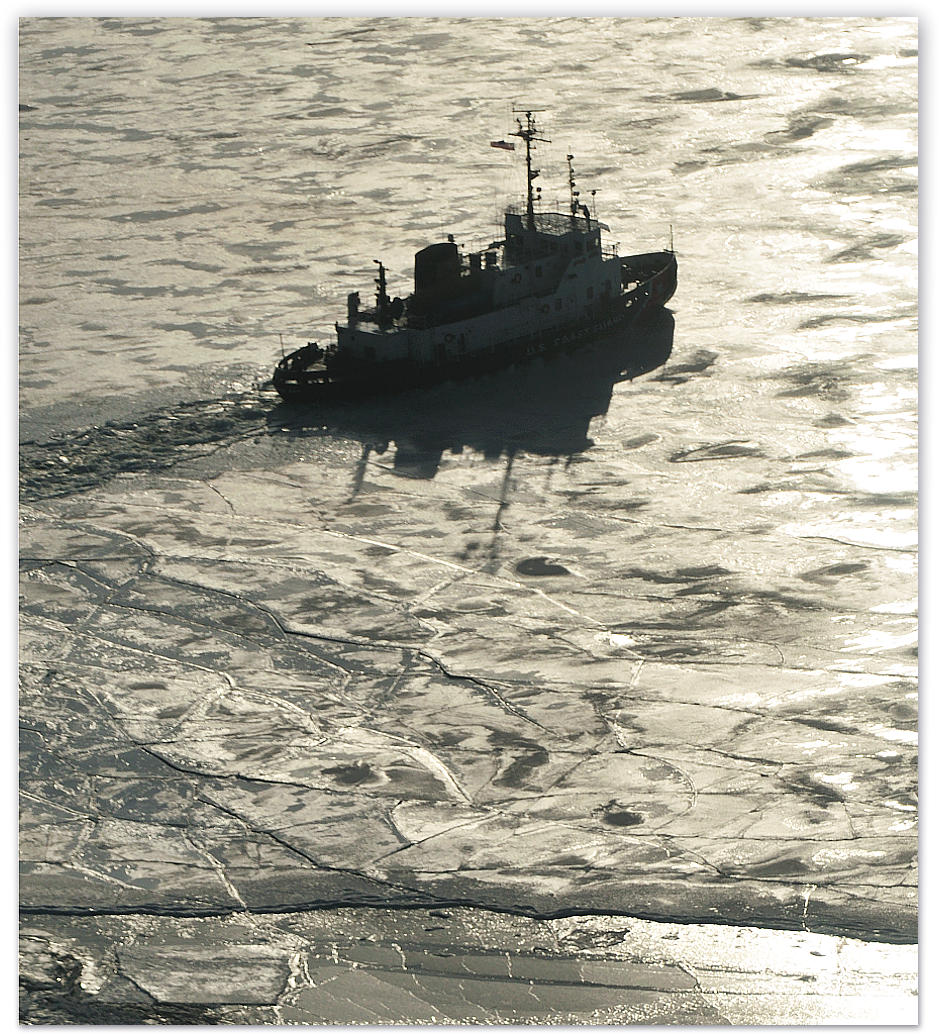
Occasionally the pure white tectonic plates were broken by long cracks. In places jagged-edged cakes with as much variety as nowflakes congregated along the ice shelf’s border.
A tiny red model lighthouse appeared on the icy horizon, and after a minute more became the White Shoal Light, towering in all her grandeur above the ice shelf, a small ice cave at her base where waves whipped over the foundation rocks and froze.
The Old Waugoshance Point Lighthouse |
White Shoal Lighthouse |
Grays Reef Lighthouse |
Skillagalee in Winter |
After a quick loop we proceeded on our way, flying over the ghostly Waugoshance Lighthouse. Boulders jutted from the ice shelf, a single ladder linking the rock outcropping to the deck. The walls were stained with rust, and the brick tower was crumbling.
With the roof burned off from the WWII target practice that left the metal bullet-ridden, we peered down into what was once the height of technology, absolutely vital to lake transportation.
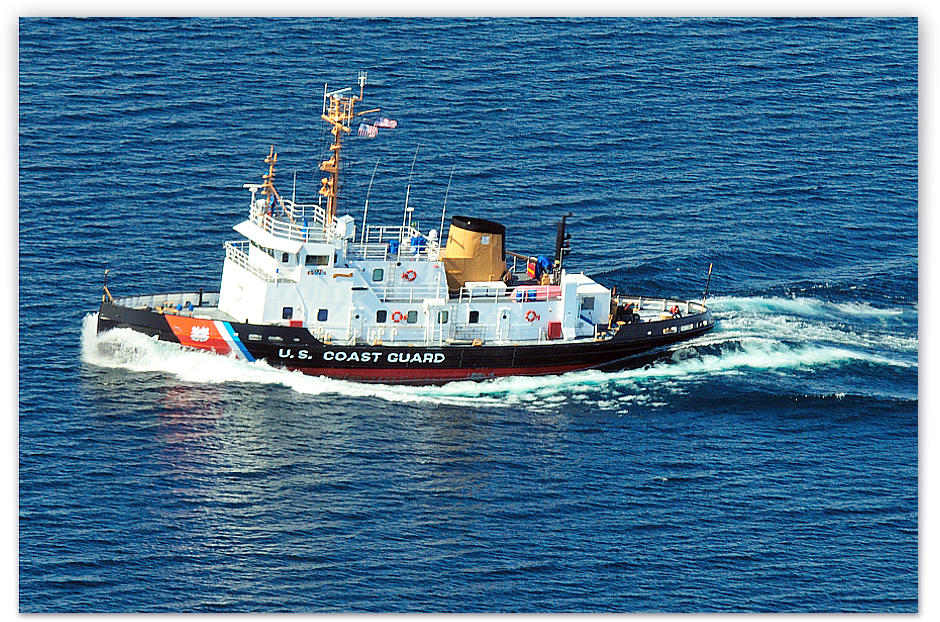
Spotting smoke on the horizon, we followed a freshly broken 40' channel through the ice. In a few places it abruptly curved; either the ice proved too slow to break in a given direction, or open water was spotted in another. Passing the modern Gray’s Reef Lighthouse, we spotted the Bay, which had just broken free. After hours of forging ahead through the lake’s thick skin, the captain was now really putting the coal to her, steaming to Charlevoix at 14 to 15 knots.
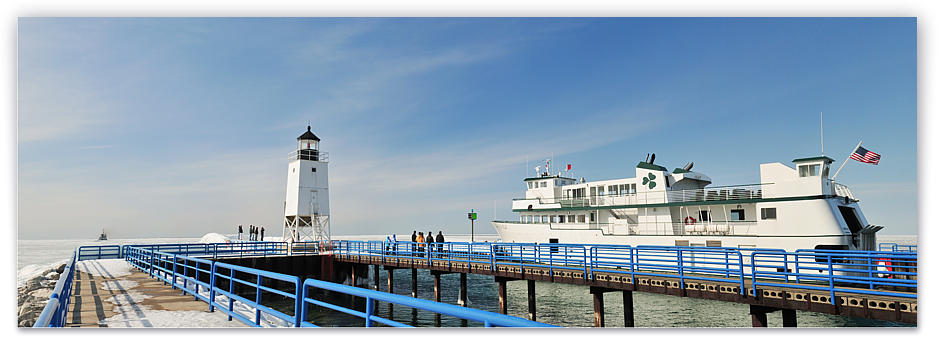
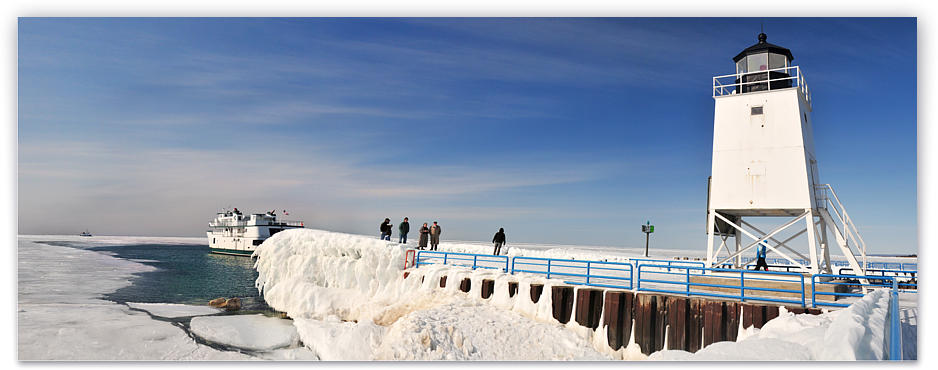
The crew of the Emerald Isle was ready, Mike Green and Kevin McDonough standing by on her bridge. The Bay radioed that she was 30 minutes out, so the bridge keeper was called back in. People gathered at the breakwater, and at last, at around 4:40 p.m., the Emerald Isle made her way out of Round Lake past the two ice-covered peers and into the freshly-cut channel leading to the freedom of open water.
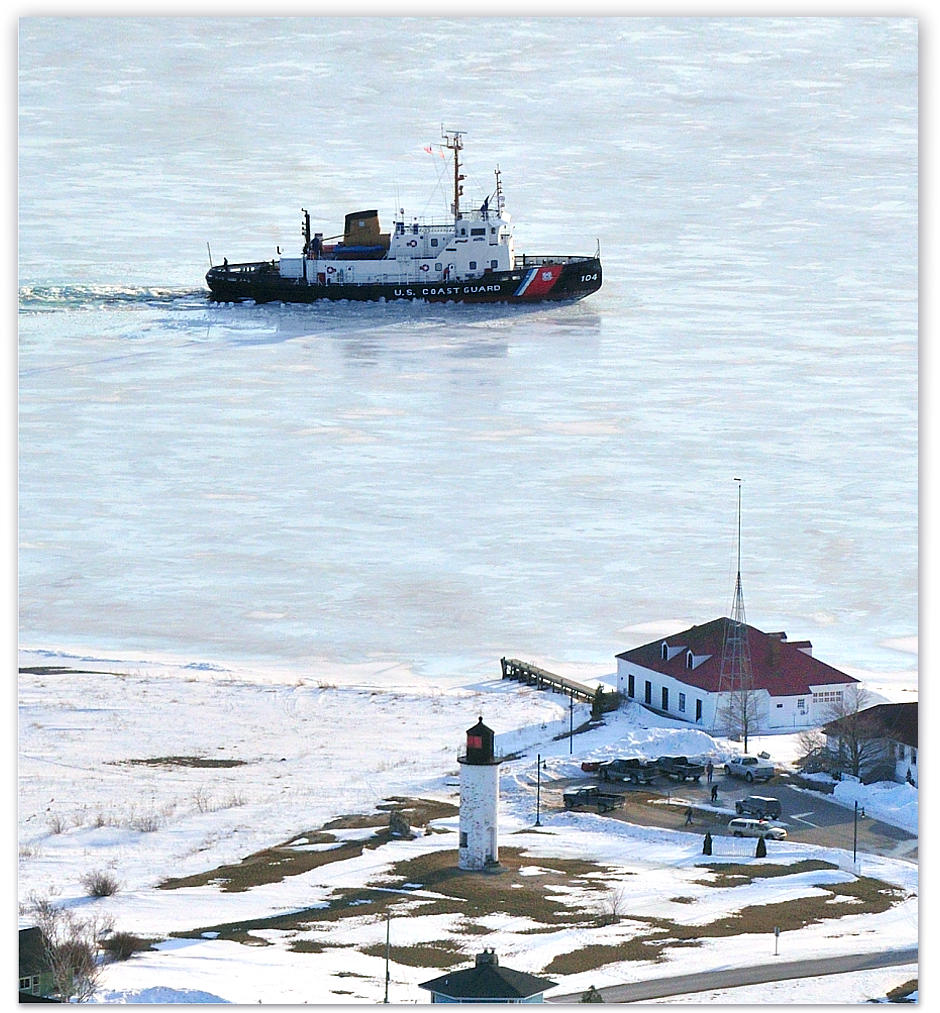
The ice was still 16" thick beyond the mouth of the harbor, but only one or two back-downs were required by the Biscayne Bay. Generally she sliced through the ice of the harbor with relative ease.
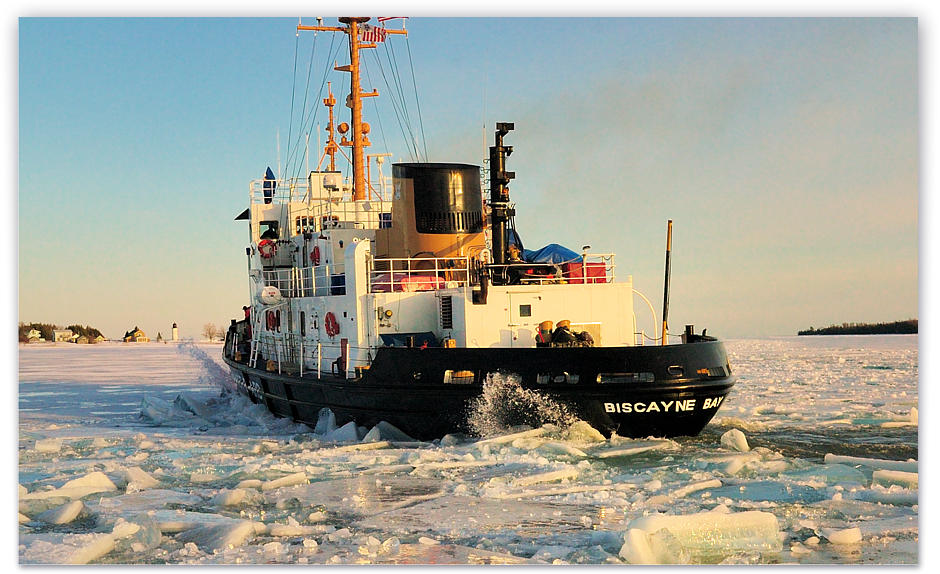
With a few smooth passes and an air-hull lubrication bubbler system blowing ice away from her hull, she cleared a path to the dock in short order to the cheers of a gathering of children and adults—an Island tradition.
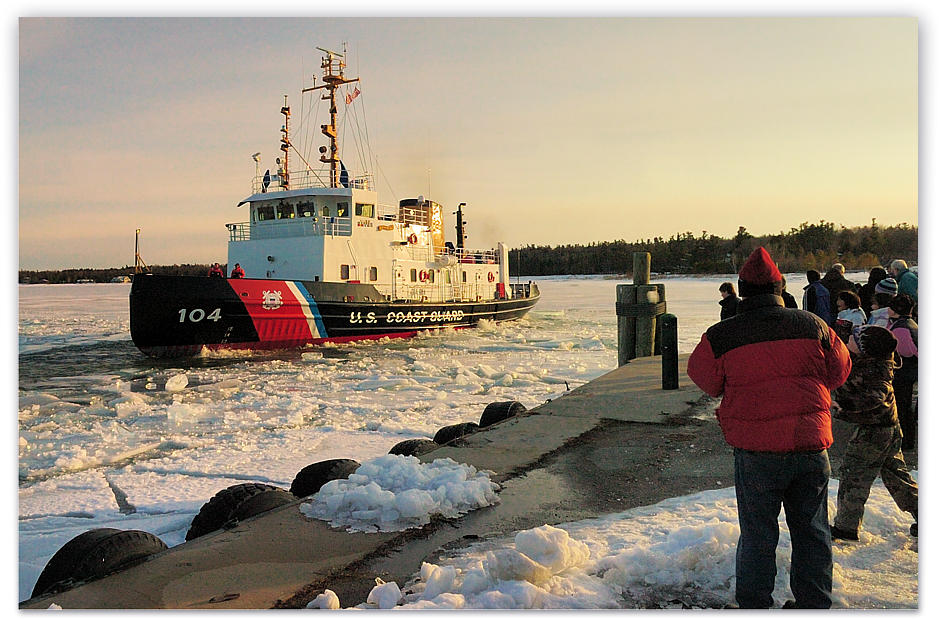
The ice had been cleared from the Emerald Isle’s berth that morning by the two backhoes standing by on the dock and the finger pier, but when the harbor ice was broken, large chunks floated in and had to be scooped out one by one. The work proceeded diligently as the sun went down.
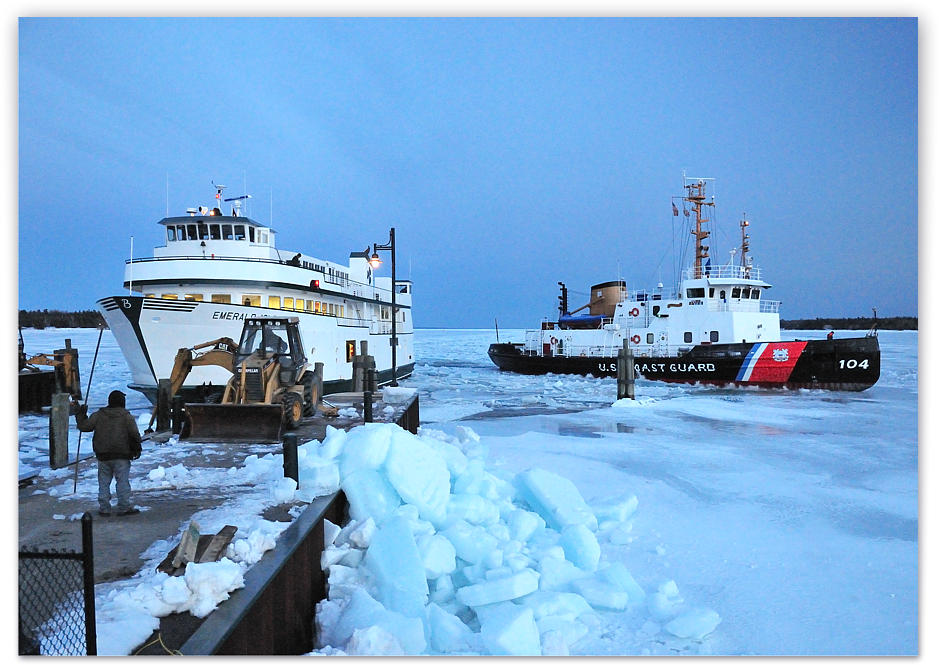
The Bay had intended to escort the Emerald Isle, with its empty gas tanker, back to Charlevoix. But she had other pressing duties on her schedule and had to leave. So the ferry and the gas tanker were stranded here—solidly frozen in by morning. But at least fuel was now in adequate supply to see Islanders through until the boats can begin their regular runs.
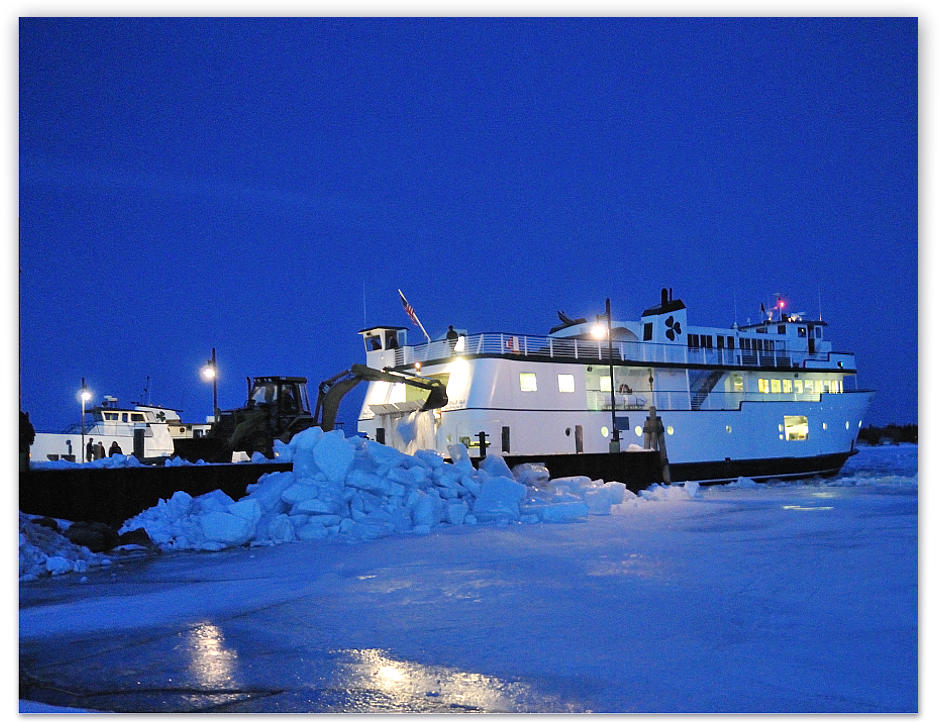
When a good plan doesn’t work, improvisation is required. That happened here when the Biscayne Bay ran out of time and had to steam away, leaving the Emerald Isle and the gas tanker it was carrying marooned at St. James. Luckily, Bud Martin, who was responsible to get the tanker back to Charlevoix, was born on Beaver Island, and knew how to improvise. All he had to do was get James Kenwabikise to break out the frozen cakes from the channel the Bay had cut with his steel-hulled fish tug, the Ruby Ann, which was still frozen in place.
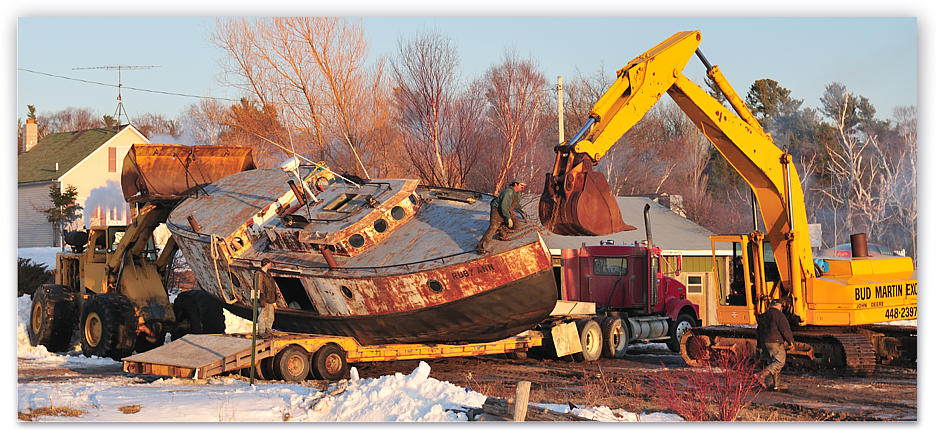
Sound easy?
Sure; all it took was a miracle.
The first problem was to make sure the fish tug would run, and it wouldn’t —at least not until Bud and James installed a new starter. The next was to get her to the mouth of the harbor, where the channel began, from her dock on the north shore. But the entire harbor was frozen solid with ice over a foot and a half thick. There seemed to be no way to accomplish this—but Bud, Travis, and Nathan had a way.
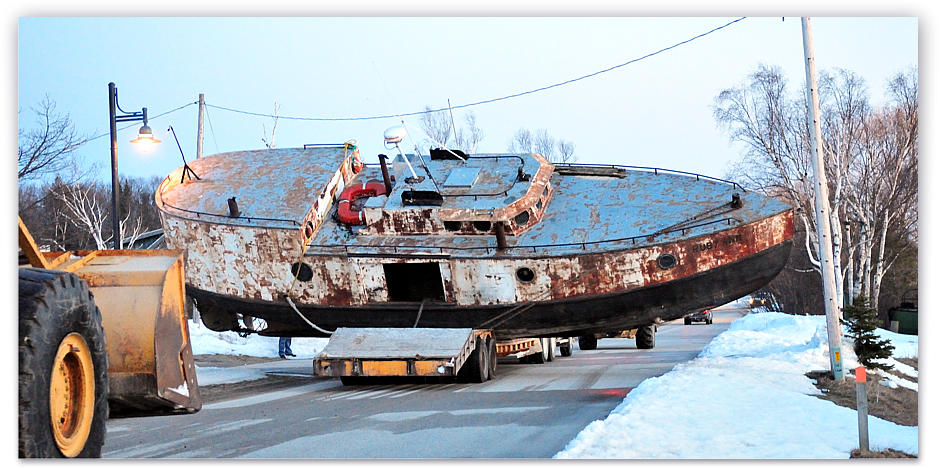
First Bud had to tow the Ruby Ann a few hundred feet along the shore through the thinner ice to where he could pull it onto land with the heavy equipment at his dock.
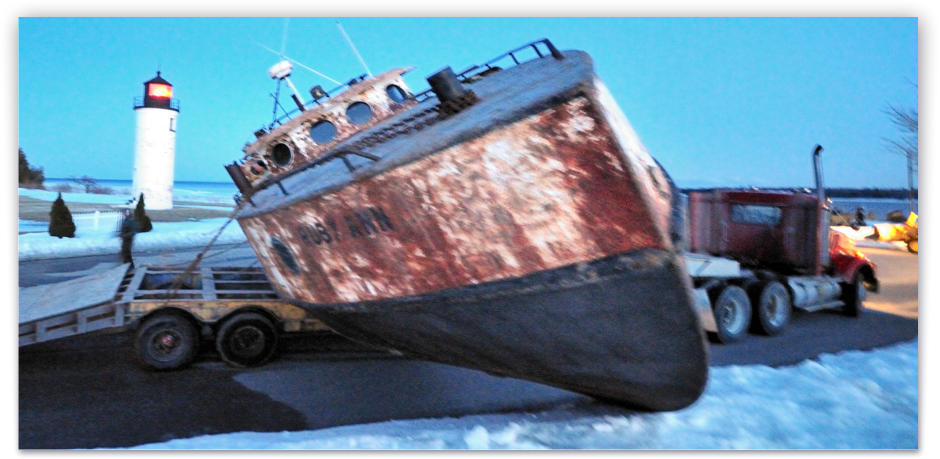
Once it was out of the water, Bud attached chains from its bow and stern to his excavator and his terex, and lifted it just high enough so his semi could back a flatbed trailer under it. Once it was lowered onto the trailer and balanced, it could be chained down—perpendicular to the trailer.

The next task was to get the truck onto the road, which required Bud to level a path with his terex. Then, after some back-and-forthing to line it up, he could use his loader to tow the trailer and truck up the hill onto Michigan Avenue.
The idea was to move it to Point and put it in, a task made difficult by the trees and telephone poles. But she made it with an inch to spare.
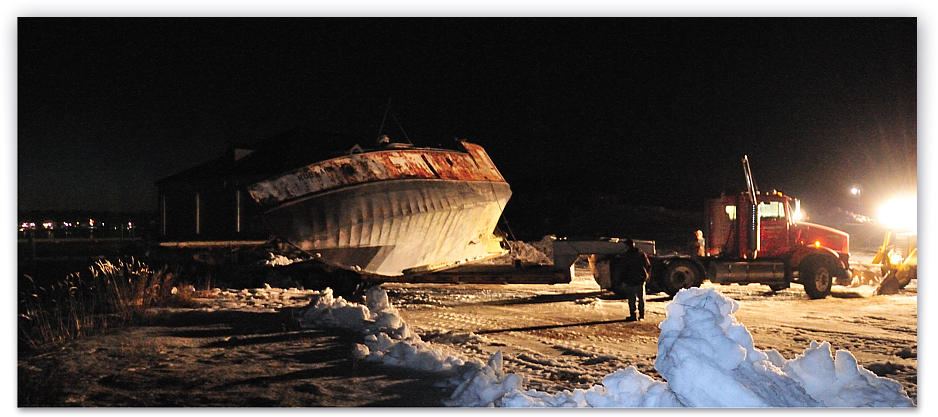
By now the sun had set, so further work had to be done in the dark, with light provided by Bud’s equipment and the ring of cars gathered on the slight bluff. Using his terex, Bud’s men made a path south from the street’s end to the lower plateau at the edge of the ice, and then scraped the snow away to allow the truck to be placed where he wanted it—a position he achieved by shoving the rig sideways. By ten that night he was ready to push the Ruby Ann off into the snow just above the shore, where she would sit through the night.
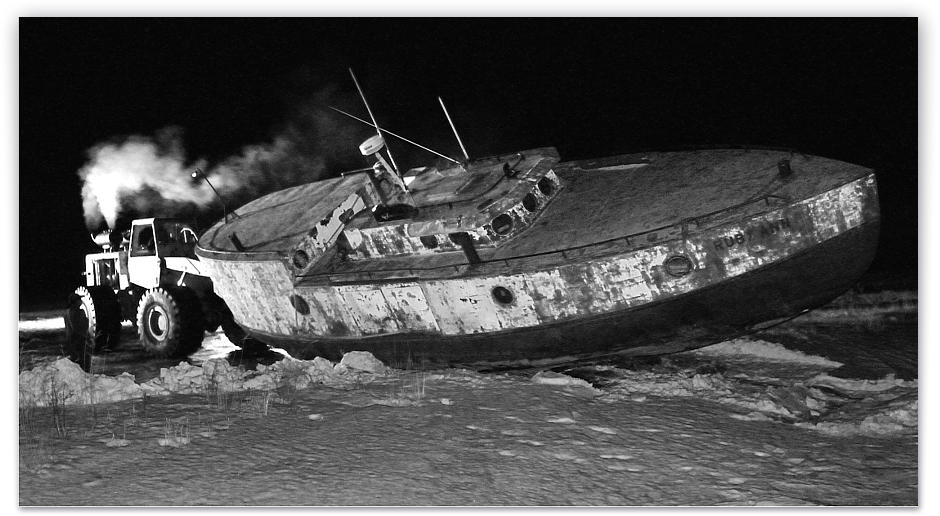
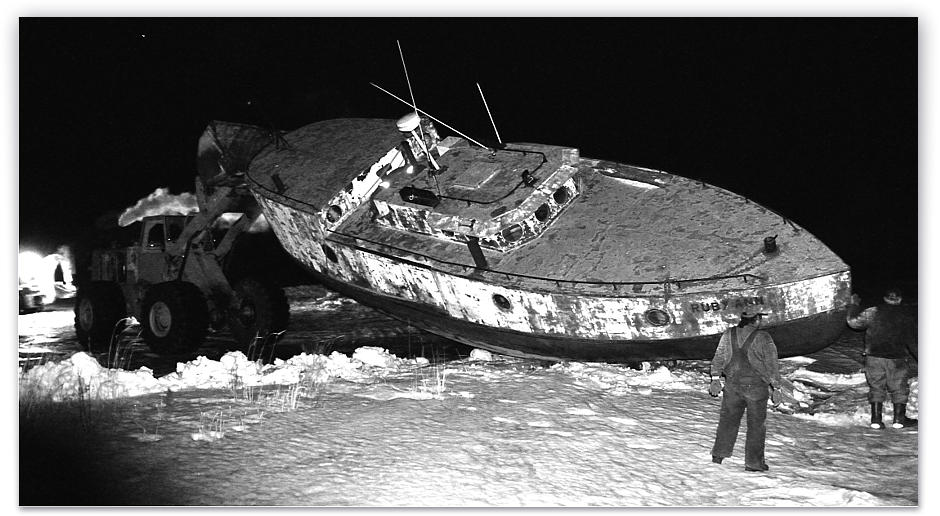
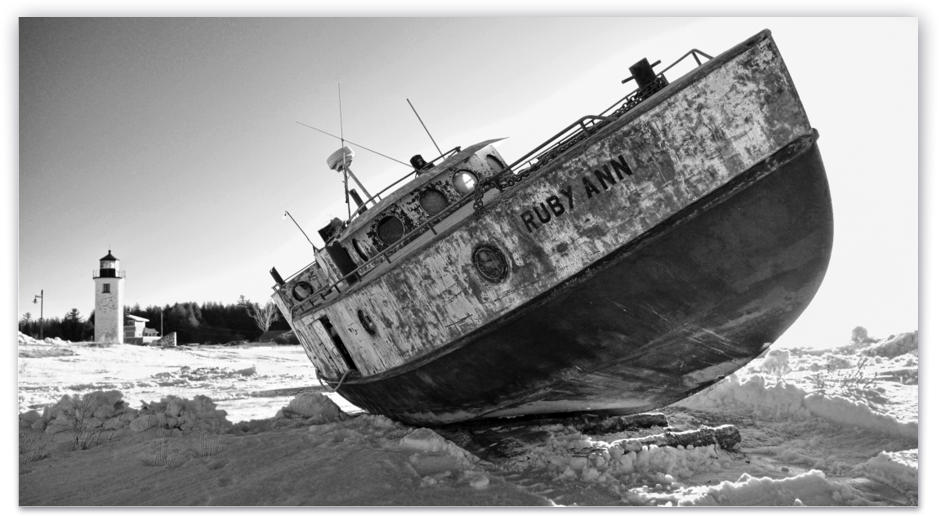
The crew showed up early in the morning. James arrived first to prep his tug, which included greasing the shaft and installing the prop.

Bud’s sons began cutting a channel for the tug in the ice, which was clear, sparkling, and 18" thick. Bud used his backhoe to knock out chunks of ice and either push them under the shelf or set them on top, to the side. By noon the waterhole was large enough for the tug, and, after sanding the ground for traction, she could be skidded the final fifty feet into the lake.

It took awhile to get the Cummins diesel started, but once it was running James used his expertise to slowly ram his way toward open water, with help from Galen Bartels. Some of the ice had been sawed through, but it did not want to give way and required dozens of rammings.

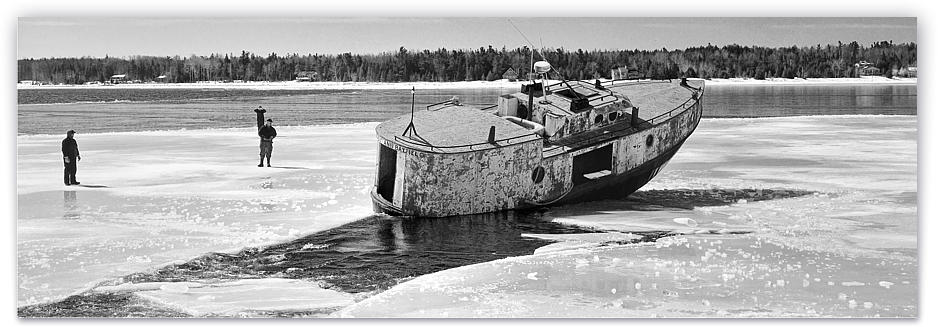
The Ruby Ann pitched and rolled, sank down a little, and then backed down into the water, scooping untold gallons into its bilge each time—the pumps ran constantly. Despite the danger, James performed like a master sculptor, chinking some ice off here and then there and gradually making his way out of the ice. With a bit more sawing, in only an hour he was steaming free.

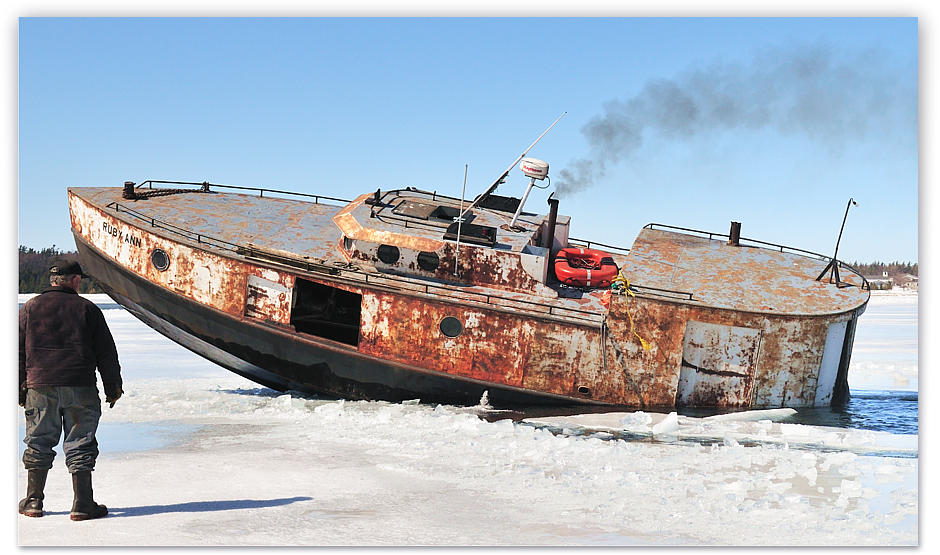
Then the next phase began — ramming through the icebreaker’s channel so the ferry could leave—which she did at 4:00 that afternoon.


Counting the costs of chartering the special hazmat ferry run, the daily fee on the stranded gas tanker, and all the effort and expense that went into the operation, it’s not difficult to see why gas costs what it does on Beaver Island. Those who witnessed the March 28-29 operation had to agree that, considering everything, it’s a bargain.

This story appeared in the April 2008 Beacon.
The Winter Run, Breaking the Channel, & The White Shoal, Grays Reef, the Old Waugoshance Lighthouses in Winter |
A Summer Ligthouse Quest to Skillagalee, White Shoal, Grays Reef, the Old Waugoshance Light, Squaw Island, Lansing Shoals, and the South Fox Island Lighthouses. |